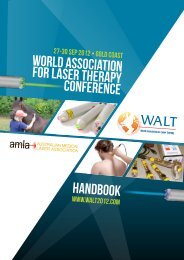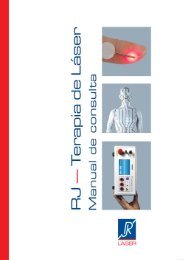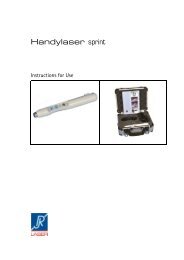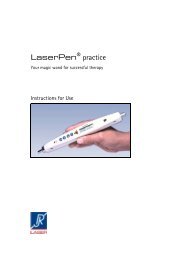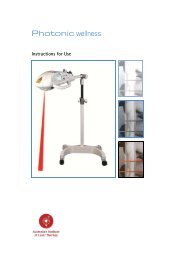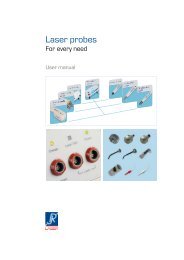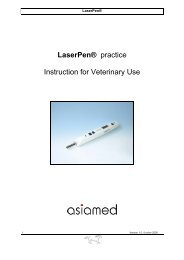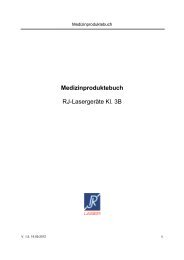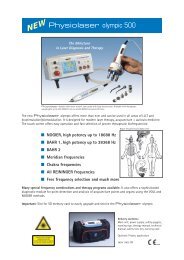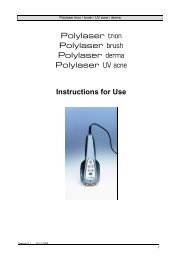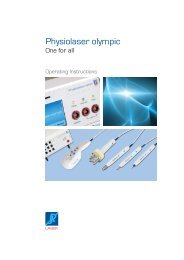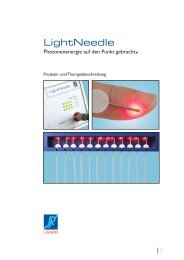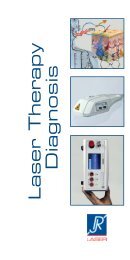LightNeedle - RJ Laser
LightNeedle - RJ Laser
LightNeedle - RJ Laser
You also want an ePaper? Increase the reach of your titles
YUMPU automatically turns print PDFs into web optimized ePapers that Google loves.
Photomedicine and <strong>Laser</strong> Surgery<br />
Volume 26, Number 4, 2008<br />
© Mary Ann Liebert, Inc.<br />
Pp. 301–306<br />
DOI: 10.1089/pho.2007.2188<br />
Abstract<br />
<strong>Laser</strong>-Needle Therapy<br />
for Spontaneous Osteonecrosis of the Knee<br />
Winfried Banzer, M.D., Ph.D., 1 Markus Hübscher, Ph.D., 1 and Detlef Schikora, Ph.D. 2<br />
Objective: This case report describes the treatment of a 63-year-old patient with spontaneous osteonecrosis of<br />
the knee (SONK). Background Data: SONK usually appears in the elderly patient without the typical risk factors<br />
for osteonecrosis. It is characterized by acute and sudden pain, mostly occurring at the medial side of the<br />
knee joint. Symptoms usually worsen with physical activity and improve with rest. Besides physical therapy,<br />
limited weight-bearing and the use of analgesics and nonsteroidal anti-inflammatory drugs, we propose lowlevel<br />
laser therapy (LLLT) as a conservative treatment option. Methods: LLLT was carried out using laser needles<br />
emitting radiation with wavelengths of 685 and 885 nm, and a power density of 17.8 W/cm 2 . Therapy sessions<br />
lasted 60 min and were performed daily over a period of 3 mo. The total irradiation dose emitted by 8<br />
laser needles in 60 min of treatment was 1008 J. Results: Magnetic resonance imaging revealed distinct restitution<br />
of the spongiosa edema 5 wk after treatment onset, and the final check-up at 35 wk demonstrated complete<br />
restoration of integrity. Conclusion: The present case report provides the first indication that laser-needle<br />
therapy may be a promising tool for complementary and alternative therapeutic intervention for those with<br />
SONK.<br />
Introduction<br />
STEONECROSIS OF THE KNEE was first described by Ahlbäck<br />
Oand<br />
colleagues in 1968, and has been classified into two<br />
distinct types: (1) spontaneous or idiopathic osteonecrosis,<br />
and (2) secondary osteonecrosis associated with various risk<br />
factors such as steroid therapy, renal transplantation, systemic<br />
lupus erythematosus (SLE), alcohol abuse, caisson decompression<br />
sickness, Gaucher’s disease, and hemoglobinopathies.<br />
1,2 Spontaneous osteonecrosis of the knee<br />
(SONK) usually appears in the elderly patient over 55 years<br />
of age without the typical risk factors for osteonecrosis, with<br />
an age-related prevalence between 3.4% and 9.4%. 3 Women<br />
are three times more often affected than men. SONK is characterized<br />
by acute and sudden pain, mostly occurring at the<br />
medial side of the knee joint. Symptoms usually worsen with<br />
physical activity and improve with rest. Also, nocturnal pain<br />
is frequently observed, and clinical examination shows local<br />
hypersensitivity to pressure. 4 Even though the precise etiology<br />
still remains unclear, two major theories have been proposed.<br />
5 The traumatic theory suggests that repeated microtraumata<br />
in porotic bone cause stress fractures and<br />
301<br />
successive necrosis. 6 According to the vascular theory, occlusion<br />
of the blood supply at the arterial and venous side<br />
may lead to decreased bone microcirculation with subsequent<br />
edema formation. Edema increases bone marrow pressure,<br />
further diminishing the blood supply and resulting in<br />
osseus ischemia and necrosis. 4 Furthermore, elevated bone<br />
marrow pressure due to increased fat cell size and fat microemboli<br />
has been suggested to impair intraosseus microcirculation.<br />
7 Established treatment options comprise physical<br />
therapy, limited weight-bearing, and the use of analgesics<br />
and nonsteroidal anti-inflammatory drugs. These conservative<br />
approaches are recommended, usually in the early<br />
stages of disease. But even in such cases, progression can not<br />
always be successfully hindered, and patients with severe<br />
necrotic changes may require surgical intervention (e.g., high<br />
tibial osteotomy or total knee replacement). 2,8–10 In this context<br />
and in consideration of the basic research on the biostimulatory<br />
effects of low-level laser therapy (LLLT) on microcirculation<br />
and vascularization as well as on osteogenesis,<br />
and its clinical effectiveness in bone and joint diseases such<br />
as osteoarthritis and rheumatoid arthritis, we propose LLLT<br />
as a promising therapeutic option for patients with<br />
1 Department of Sports Medicine, Goethe-University Frankfurt/Main, and 2 Department of Physics and Optoelectronic, University of<br />
Paderborn, Germany.



